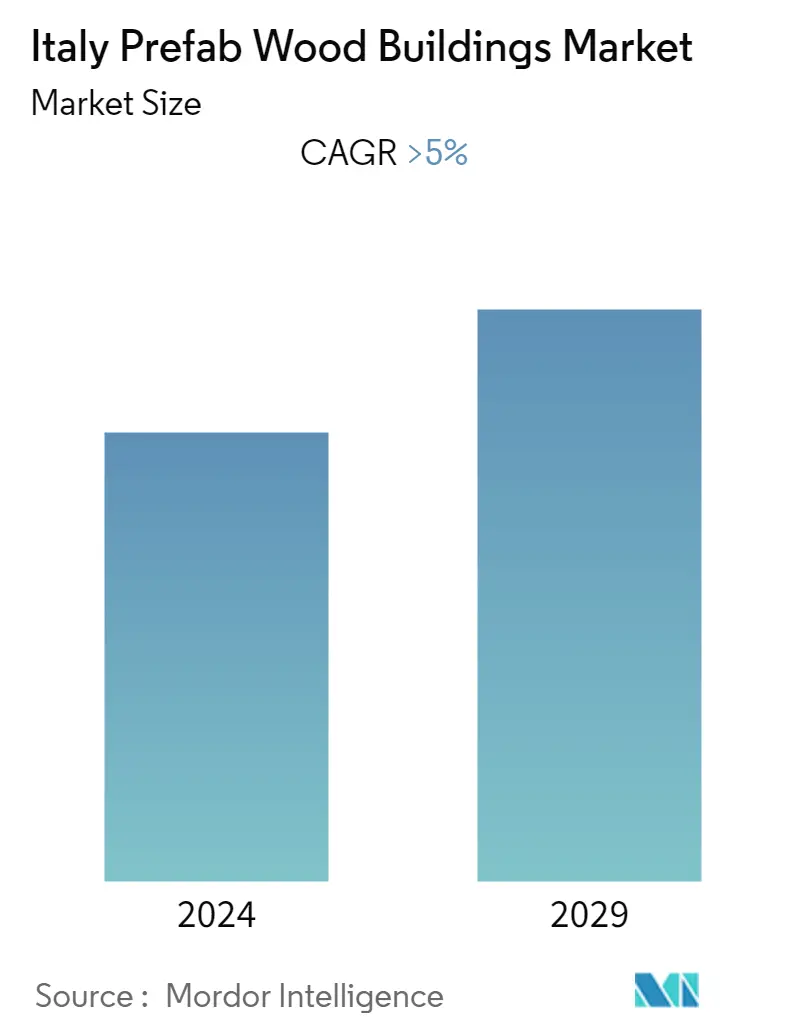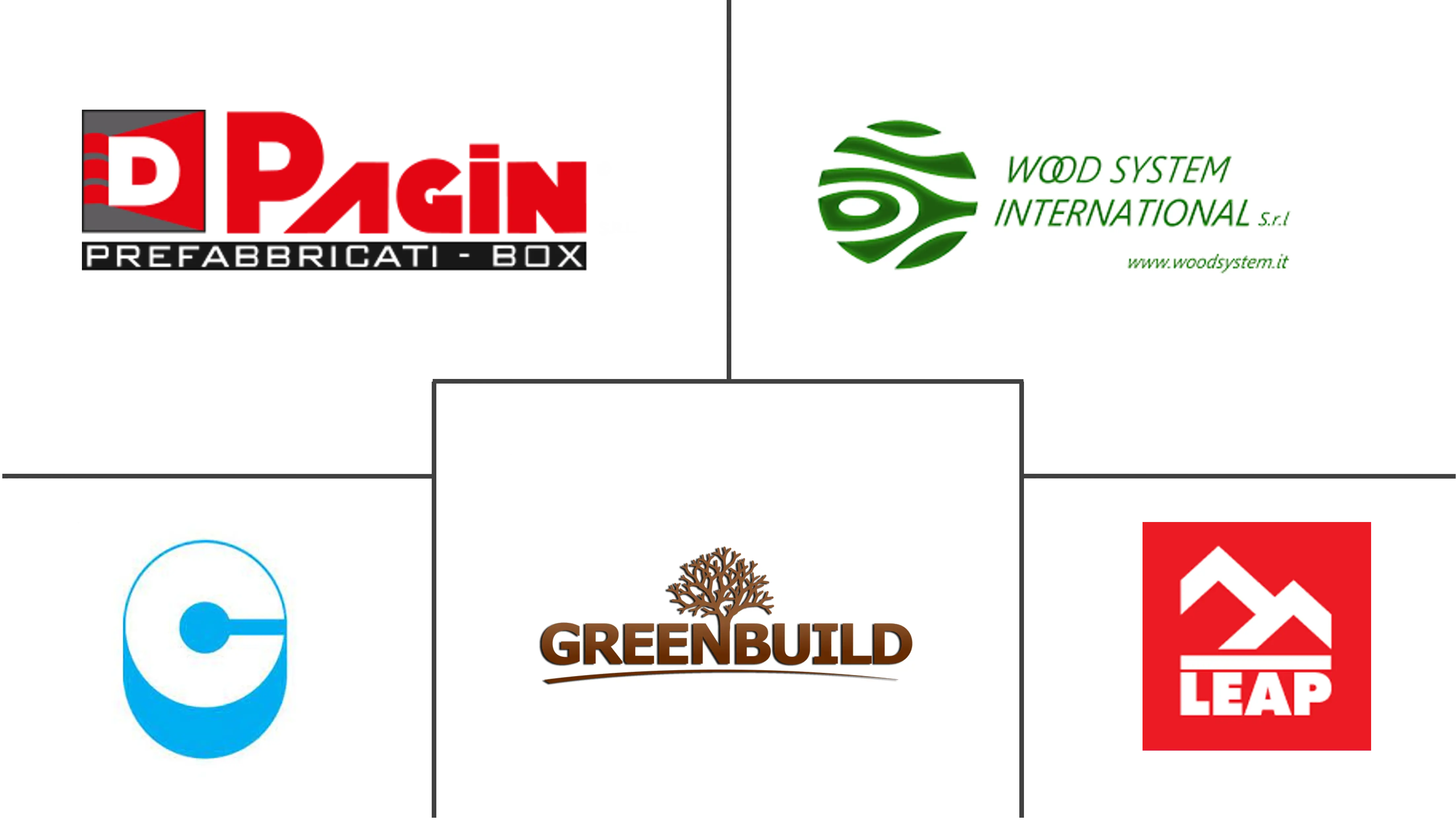Market Size of Italy Prefab Wood Buildings Industry

| Study Period | 2020 - 2029 |
| Base Year For Estimation | 2023 |
| Forecast Data Period | 2024 - 2029 |
| Historical Data Period | 2020 - 2022 |
| CAGR | 5.00 % |
| Market Concentration | Medium |
Major Players
*Disclaimer: Major Players sorted in no particular order |
Italy Prefab Wood Buildings Market Analysis
- The Italy Prefab Wood Buildings Market is expected to grow at a CAGR of more than 5% during the forecast period driven by smart and self-sufficient housing construction.The market for prefabricated wood buildings is expanding and gaining popularity as more people become aware of the high levels of customization and quick construction timeframes that prefabricated housing offers. New prospects are opening up for the construction of different manufactured homes, modular homes, panelized homes, and precut homes thanks to smart technologies and effective green techniques.
- Future wood house construction activities are anticipated to rise reasonably, thanks to real estate investments and rising disposable income globally. Additionally, the negative effects of CO2 emissions from cement production have turned consumer attention to wood-frame construction. For instance, one of the two industries that produces the most CO2 is the cement business. Additionally, favourable government initiatives to reduce carbon emissions have promoted the building of wood houses, giving the market the boost it needs for the wood structures business.
- Italy actively supports timber building and wants to increase the percentage of multi-family homes in the country. In order to lessen the negative environmental effects of CO2 emissions from the construction industry, local governments and municipalities have their own policies, which directly affects the amount of wood used in new buildings' structural components. Currently, the structural weight-bearing system of 20% of the new multistory residential complexes is constructed of wood.
Italy Prefab Wood Buildings Industry Segmentation
Prefabricated wood construction kits, similar to life-sized Legos, are constructed out of prefabricated components that are supplied and installed on-site. This is most commonly accomplished by the use of prefabricated panels that may create complete portions of a building, such as roofing components or structure (ceiling, decking, and beams), building structure (wall panels, beams, columns, and shear paneling), and even glazing packages.
The Italy Prefab Wood Buildings Market is segmented By Panel Systems (Cross-laminated timber (CLT) panels, Nail-laminated timber (NLT) panels, Dowel-laminated timber (DLT) panels, and Glue-laminated timber (GLT) columns and beams), and By Application (Single Family Residential, Multi-family Residential, Office, Hospitality).
| Panel Systems | |
| Cross-laminated timber (CLT) panels | |
| Nail-laminated timber (NLT) panels | |
| Dowel-laminated timber (DLT) panels | |
| Glue-laminated timber (GLT) columns and beams |
| Application | |
| Single Family Residential | |
| Multi-family Residential | |
| Office | |
| Hospitality | |
| Others |
Italy Prefab Wood Buildings Market Size Summary
The Italy Prefab Wood Buildings Market is experiencing significant growth, driven by the increasing demand for smart and self-sufficient housing solutions. The market is gaining traction due to the high levels of customization and rapid construction timelines offered by prefabricated wood buildings. The adoption of smart technologies and green building techniques is opening new opportunities for various types of manufactured homes, including modular, panelized, and precut homes. The shift towards wood-frame construction is also influenced by the environmental concerns associated with CO2 emissions from traditional materials like cement, prompting both consumer preference and supportive government initiatives aimed at reducing carbon footprints. Italy's commitment to increasing the use of timber in construction, particularly in multi-family homes, is further bolstered by local policies encouraging the use of wood in structural components to mitigate environmental impacts.
Italy has emerged as a leading player in the European wooden building industry, surpassing countries with a long-standing tradition of timber construction. The country has seen a rise in the consumption of wood-based preassembled components, supported by government initiatives promoting energy efficiency in the construction sector. The use of modular timber structures, which store significant amounts of carbon, offers advantages in both new construction and the renovation of existing buildings. The Italian market is witnessing a growing interest in wood-based products due to their mechanical properties and environmental benefits. As the demand for timber-framed panels increases, Italy continues to lead in prefabricated construction within the EU, with a substantial share of the market. The sector's growth is expected to continue, driven by moderate economic growth, increased investments in prefab construction, and the expansion of product offerings and technological advancements.
Italy Prefab Wood Buildings Market Size - Table of Contents
-
1. MARKET DYNAMICS AND INSIGHTS
-
1.1 Market Overview
-
1.2 Market Drivers
-
1.3 Market Restraints
-
1.4 Market Opportunities
-
1.5 Value Chain / Supply Chain Analysis
-
1.6 Industry Attractiveness - Porter's Five Force Analysis
-
1.6.1 Threat of New Entrants
-
1.6.2 Bargaining Power of Buyers/Consumers
-
1.6.3 Bargaining Power of Suppliers
-
1.6.4 Threat of Substitute Products
-
1.6.5 Intensity of Competitive Rivalry
-
-
1.7 Government Regulations and Initiatives
-
1.8 Technological Trends
-
1.9 Brief on Different Structures Used in the Prefabricated Buildings Industry
-
1.10 Cost Structure Analysis of the Prefabricated Buildings Industry
-
1.11 Impact of COVID-19 on the Market
-
-
2. MARKET SEGMENTATION
-
2.1 Panel Systems
-
2.1.1 Cross-laminated timber (CLT) panels
-
2.1.2 Nail-laminated timber (NLT) panels
-
2.1.3 Dowel-laminated timber (DLT) panels
-
2.1.4 Glue-laminated timber (GLT) columns and beams
-
-
2.2 Application
-
2.2.1 Single Family Residential
-
2.2.2 Multi-family Residential
-
2.2.3 Office
-
2.2.4 Hospitality
-
2.2.5 Others
-
-
Italy Prefab Wood Buildings Market Size FAQs
What is the current Italy Prefab Wood Buildings Market size?
The Italy Prefab Wood Buildings Market is projected to register a CAGR of greater than 5% during the forecast period (2024-2029)
Who are the key players in Italy Prefab Wood Buildings Market?
Pagin Srl, Wood System International S.r.l., Leap Factory srl, CO.RI.MEC. Italiana S.p.A and Greenbuild Srl are the major companies operating in the Italy Prefab Wood Buildings Market.

